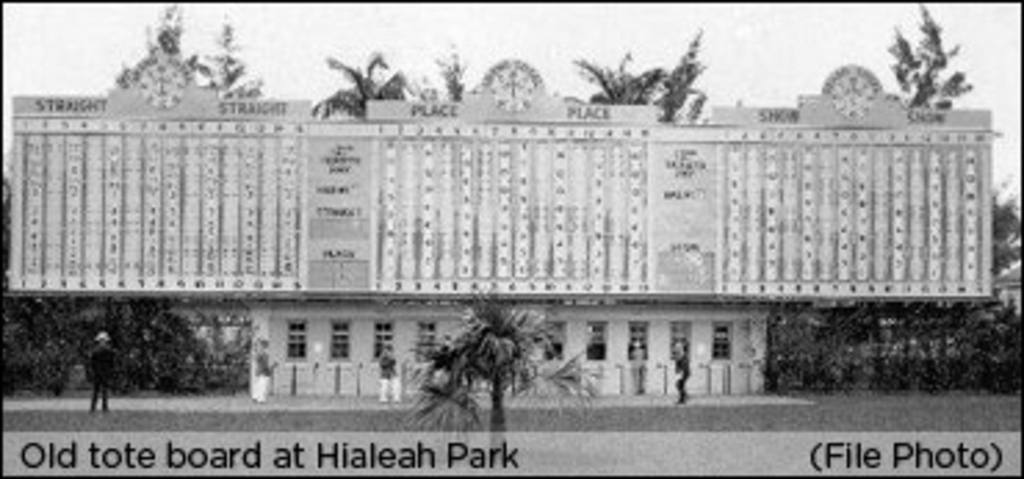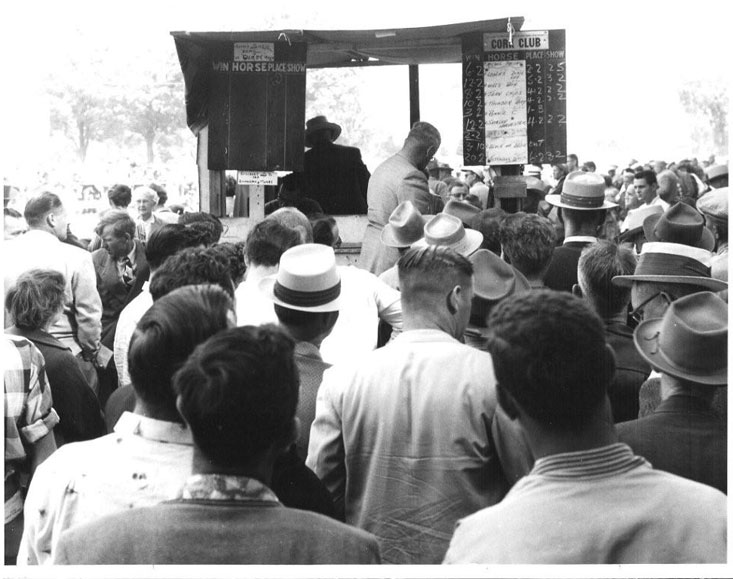
In this week's Rewind Robert Smith reminds us of the days before the Tote Board was such an important focal point at every racetrack
.
Much of this week's story is told by looking at the old photograph that accompanies this piece. It is part of my own personal collection and was taken many years ago by a London Free Press photographer at New Hamburg, Ont. and later retrieved from the paper's archives. In order to fully extract all of the details I have spent a fair amount of time going over it, often with the aid of a magnifying glass, always a blessing for these aging eyes.

I am sure that it is almost unimaginable for modern day race goers to ever think that harness racing could be staged without a tote board. How would you know what the odds are, what about the fractional times of a race? Never mind the current temperature, the time of day and the latest scratches and driver changes and "Minutes To Post".... Well, a lot of races were held years ago without a tote board, but it did not mean that spectators were completely deprived of important information or were not able to place a wager. Also it made you listen a little more closely to the announcer who was perched high in the infield judge's stand keeping everybody informed.
When a day of racing was being held, a small "makeshift" shed type of structure was set up for the occasion or in some instances an existing building was used. Prior to each race the book maker or one of his assistants printed out the names of the horses on a paper and pinned it on one of two notice boards located at the betting shed. Next to the horses names there was a slate where the odds were written using chalk and updated as the bookmaker saw fit. It is interesting to note that odds were most often quoted at "To: 2 ", while today's standard is more frequently "To: 1". Often other announcements were displayed if deemed necessary, usually in the form of a small hand written note. You might quite quickly conclude that "technology" was not an integral part of this set up.
It is important to point out that NO "Payoff Prices" were posted as this was not pari-mutuel wagering. When a person cashed a winning ticket it was paid off at whatever odds it was purchased at, so not everyone received the same amount. Just exactly how the bookmaker determined the odds and ran the system aimed at making a profit I cannot explain. "Bookmakers" were supposed to be licensed and usually were, and I would guess there were many who worked in various areas of the country. Two that I know of were Cliff "Chappy" Chapman and John Hayes, both well known for other reasons.
Here is a recap of what was shown on the board in the accompanying picture:
The rate of U.S. - Canadian exchange was 5% reduction of a U.S dollar that day as per a small notice at the bottom left hand corner.
Horse No. Horse Name Odds to win Place Show 1. Leola's Dixie Lee 6-2 2-2 2-5 2. Wills Boy 12-2 5-2 3-2 3. Jean Chips 8-2 4-2 2-2 4. Thunder Bay 10-2 4-2 3-2 5. Ronnie C. 3-2 1-2 Out 6. Shirley Harvester 12-2 4-2 2-2 7. Field (see below) 2-2 Out Out 8. Black 'N Blue 10-3 Out Out 9. Victorious Direct 20-2 6-2 3-2
The outcome of the race saw Black 'N Blue as the winner of both heats as predicted by the odds maker. This young four-year old mare was owned by John Johnson from the metropolis of Mull, Ont. and driven by a gentleman named Ernie Campbell of Rodney. She was appropriately named, being black in colour and sired by Blue Again - a noted horse of this era. Notice there was NO place or show wagering offered as she was such a prohibitive favourite. It also looked like you could purchase a ticket on the entire field (other than the favourite) at even money.
I had the pleasure of meeting Mr. Campbell many years ago when he was about 90 years of age and residing at a Senior's home in Dutton. He was a gentleman of the old order and a man who truly loved horses. He had lived a long and interesting life including being a school teacher at one time. It was obvious he could have done many things but chose to train and race horses.
The idea of the Tote board is nearly 100 years old and its invention is credited to a fellow named George Julius who first introduced it in 1913 at Ellerslie Racecourse in New Zealand. The first tote board in our part of the world occurred in 1932 when Hialeah Park in Miami, Florida installed one for thoroughbred racing. Just when it first appeared in Canada I am uncertain but I do know that 60 years ago at Thorncliffe Park in Toronto a fairly modern looking board is visible in old photographs.
Where would we be without it today?

